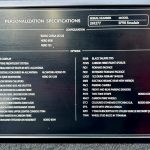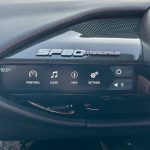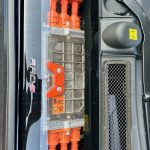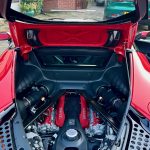Ferrari’s Hybrid Hypercar

Over a decade ago, in 2013, Ferrari introduced its first hybrid vehicle, the ultra-exclusive Ferrari LaFerrari. Despite the silly name, which has now almost universally been shortened to LaFerrari, buyers were not put off and demand for the high-revving, 950 hp 6.3 litre V12 hybrid halo car was huge. Nowadays, used examples command a price tag in excess of £2 million pounds. However, instead of building on this hybrid development, Ferrari’s foray into sustainable motoring took a back seat, with focus instead being devoted to naturally aspirated V12 GTs and V8 turbo supercars. However, in 2019 this all changed, and Ferrari was back with another hybrid hypercar, the SF90.
Introduced as a 90th birthday present to the company and recognising the factory race team, Scuderia Ferrari, the SF90 ditched the high revving V12 of the LaFerrari and instead combined its tried and tested twin-turbo V8, as found in the 488 and F8 Tributo but now bored out to 4.0 litres, with 3 electric motors. What may on paper seem like a downgrade is far from reality, with the SF90 pushing out 1000 PS (986 hp). However, for some the regular SF90, if you can even call it that, lacked the interaction expected from a flagship Ferrari and was often associated with having spikey handling, especially on the limit. It certainly wasn’t the unanimous praise that one would expect from the fabled Ferrari brand. As a result, Ferrari decided to sharpen its pencil and go back to the drawing board and the result is what you see here. The Ferrari SF90 Stradale Assetto Fiorano. Reminiscent of Modifcata and HGTE handling packages which adorned earlier Ferraris, the aim of the Assetto Fiorano upgrade is to take the SF90 to the next level. The question is, has it worked?
Vehicles equipped with the Assetto Fiorano package, which is a £39,360 option, are easily identifiable by their eye-catching painted livery (no vinyl wraps here), but the keener eye will spot swathes of carbon fibre everywhere, including on the large rear ducktail spoiler which helps generate 390 kg of downforce at 155mph. Beneath the skin, the standard adaptive dampers are replaced with passive aluminium items from Multimatic, developed from Ferrari’s GT3 series, which combined with titanium springs, save 8 kg. A titanium exhaust system also features. All in, this helps lower the overall weight by 30 kg to 1570 kg dry. A further 10 kg saving comes with addition of carbon fibre alloys, a mere £19,200 a set, and shod in super sticky Michelin Pilot Cup 2 tyres. As tested, this high specification Rosso Corsa example cost £528,000 when new. For comparison, a regular SF90 Stradale before options cost just over £375,000.
Inside is a mixture of leather, alcantara and of course carbon fibre, which covers the entire doorcards, rear fire wall and instrument binnacles, helping with the 30 kg weight saving. However, in the quest for lightness, build quality remains exceptional. Naturally, this is to be expected in a car costing over half a million quid. The seats offer excellent support and whilst it isn’t the most spacious cabin, you sit low enough that at 6ft 2 my head isn’t touching the roof and I have enough leg room to get comfortable. As with most modern Ferraris, the cabin is very driver focused, with the majority of the vehicle functions controlled from the multifunction steering wheel and monitored on the large digital driver’s display. Here you can have anything from your media and navigation displayed, to your tire temperatures and pressures. The passenger does get a separate screen showing performance and allowing some control over media and climate, however in this car your primary focus is out the windscreen and not fiddling with touchscreens.
Naturally, when it comes to cars of this ilk, the first question most people ask is “how fast is it”? Well, simply put, it is like nothing I have ever experienced before. Acceleration in seventh gear at motorway speeds, will push you back into the seat with relentless urge. In third gear, the ferocity of acceleration will make your head spin, with the digital speedo increasing in multiples of 20 mph. The SF90 Assetto Fiorano takes your predisposed approach of a fast road car and throws it in the bin. The claimed 0-60 mph dash takes 2.5 seconds, but real-world tests show that this is conservative and closer to 2.0 seconds dead. However, on road, the in-gear shove seems even more alarming, which isn’t surprising given that it will accelerate to 124 mph quicker than the iconic McLaren F1 gets to 100 mph. The standing ¼ mile is taken care of in 10 seconds and the car will thump along until it runs into its 211 mph limiter. It really is a mighty thing.
Dynamically, the ride, whilst stiff, is far from unpleasant and copes well with our local nasty roads, while the steering is so laser focused it feels almost telepathic in its responses. The front end of the SF90 turns in like it’s glued to the apex of a corner. Traction out of said corners is enormous, aided by its four-wheel drive system and those sticky Michelins, and the car thumps between bends with a mighty urgency, gears hammering home quicker than any car I have experienced. Arriving at the next bend you then realise how powerful the carbon ceramic brakes with regenerative capabilities are, with the rate of deceleration as alarming as that of the acceleration.
However, the SF90 Assetto Fiorano is not just a one trick pony. Despite until recently holding the lap record around the fabled Fiorano circuit, it is equally at home doing everyday stuff. When you have dialled everything back and are just cruising about it is extremely well refined. This is all down to the super smooth gearbox in full auto mode and the exceptional hybrid system which seamlessly allows transition between using the combustion engine and full EV, at speeds of up to 70 mph. You can have your fun on the backroads but when you arrive at a town or village, pop the SF90 into full electric mode and move along in silence. It is remarkable how fast the transition between powertrains is, and there is no discernible jolt, with the noise of the engine cutting in or out being your only indication. Moreover, full EV mode isn’t a gimmick and offers up to 19 miles of full electric driving, with the batteries able to be recharged using both the engine and the regenerative braking system.
However, living with an SF90 Assetto Fiorano isn’t all plain sailing. One downside of adding the track pack is that it removes the front nose lift, so any journeys must be taken with a degree of caution and forward planning to avoid tearing off the carbon fibre front splitter. Despite this, in the short time spent with this car, it proved perfectly able to get up steep driveways and over the dreaded shopping centre speed humps so perhaps it is pretty well judged. Another worry is the optional carbon fibre alloys which if damaged cannot be repaired and must be replaced at an eye watering price. And when it comes to journeys, you really won’t be going huge distances as there is little to no storage space, save for a small front compartment. Would that bother me? Not really. If you can afford an SF90 Assetto Fiorano then you can afford to buy extra clothes at your destination should you need!
So, how to sum up the Ferrari SF90 Assetto Fiorano? All in all, it is a true technological tour de force. The workmanship, passion and attention to detail that its engineers have devoted to this car is apparent within 5 minutes of being in it. It feels incredibly special and the fact that regular punters can buy it (finances permitting), is astonishing. Be in no doubt, this is a proper Ferrari.
Thanks to the owner for the lend of the car.
Aaron McCalmont
Hypercar correspondent












